The northwest coast of Scotland is an incredibly geologically diverse stretch of coastline. In less than 150 kilometers the rocks span over 2.8 billion years of Earth history, from the Archaean Lewisian gneiss to the Tertiary volcanic province on Skye with little missing in between. Such a wide temporal spread means that any particular age of rocks is restricted to a relatively small area. This is especially the case with one particular formation found along the Stoer Coast north of Ullapool. This formation, named after the peninsula on which it is found, is a Mesoproterozoic sedimentary sequence composed primarily of sandstones and mudstones.
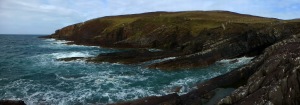 |
| The Stoer Formation |
The Stoer Formation is a sedimentologist’s dream land. It has just about every clastic sedimentary structure you can think of. From graded bedding, trough cross bedding, mudcracks, flame and pillow structures, ripple marks, you name it. Incredibly you can also see the facies transition from alluvial fanclomerates to silt- and mudstones all within a kilometer or so.
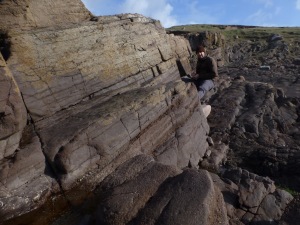 |
| Kellen at Stoer |
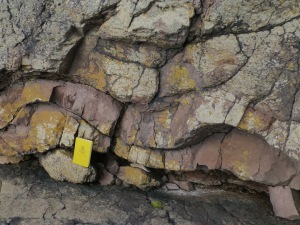 |
| Soft sediment deformation |
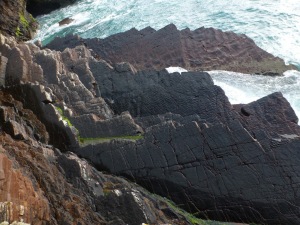 |
| 1.2 billion year old ripple marks |
However the highlight of the Stoer Formation is the Stac Fada member. The Stac Fada Member marks the junction between dominantly fluvial silt- and sandstones below deep-water lake sediments above. It however is what initially appeared to be devitrified volcaniclastic unit 10 to 20 meter thick. It is dominated by a polymict clastic-matrix breccia with accretionary lapilli.
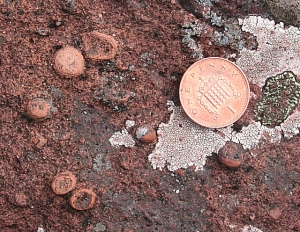 |
| Accretionary lapilli of the Stac Fada member (from Anne Burgess). |
|
Although initial investigators assumed this to be volcanic in origin it was bizzare in context of the surrounding geology. No other evidence of volcanism near this timeframe is found in the region. That was until 2008 when a team of researchers from Oxford and Aberdeen discovered shocked quartz implying the Stac Fada represented an ejecta blanket deposited by a meteorite impact. This impact was recently dated to 1177 ± 5 million years old. It was also discovered that the Stac Fada member is enriched with iridium and other platinum group elements (PGEs). The enrichment of PGEs is a very important (if not THE most important) evidence that this member was deposited following a meteorite impact. Iridium is a very rare element in the Earth’s crust. hen the Earth was first formed, the dense elements (such as iron, nickel, and platinum group elements) sank into the Earth’s interior to form the core. Asteroids and thus meteorites are also highly enriched in iridium because due to their small size, they did not differentiate and the dense elements are spread equally throughout the asteroid. For example, the Williamette meteorite found in Oregon and one of the largest ever recovered has 4.7 parts per million iridium. This is 4700 times more than the concentration of iridium in Earth’s crust.
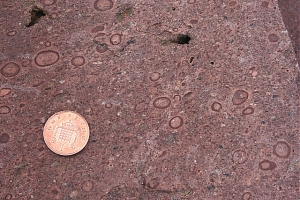 |
| Accretionary lapilli cut open to show internal structure (from Anne Burgess). |
Recently, my colleagues at the University of St Andrews found that much of this iridium is focused in the rims of this accretionary lapilli. Because lapilli form like snowballs rolling down a hill, this implies the iridium is not liberated into the atmosphere during the initial impact (when the core of the lapilli are formed), but rather released later on. I imagine this has much to do with the energy required to vaporize such dense elements. Silica has an enthalpy of vaporization of 300 kJ/mol, iron: 350 kJ/mol, gold: 330 kJ/mol. Iridium on the other hand takes 600 kJ/mol to vaporize. Although these ideas are still in their stages of naissance, it will be exciting to see how these ideas progress and evolve.
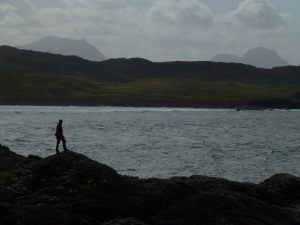 |
| Stoer bay with two Munros in the background |
 |
| A friendly ‘heelynd coo’ |
 This work is licensed under a Creative Commons Attribution-NonCommercial-ShareAlike 4.0 International License.
This work is licensed under a Creative Commons Attribution-NonCommercial-ShareAlike 4.0 International License.






![]() This work is licensed under a Creative Commons Attribution-NonCommercial-ShareAlike 4.0 International License.
This work is licensed under a Creative Commons Attribution-NonCommercial-ShareAlike 4.0 International License.

